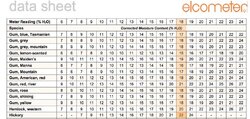The rule of thumb seems to be that most hardwoods require about 1 full year c/s/s to season properly, and oak needs 2. Just for kicks, I tested a few pieces of hickory that I cut and split in July or so. 18% was the averege reading I got. Oak from the same timeframe came in at 23%. I live in the North Carolina Sandhills, so I get pretty hot summers; well over 90* for most of July and August, with several 100*+ days.
Im wondering if my cheap Harbor Freight meter it way off, or the enviroment can really reduce seasoning time by about half.... Has anybody in warmer climates noticed this?
Im wondering if my cheap Harbor Freight meter it way off, or the enviroment can really reduce seasoning time by about half.... Has anybody in warmer climates noticed this?


